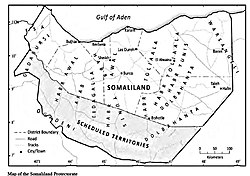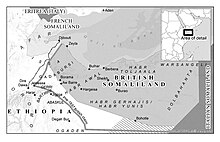| Haud
Hawd هَود هاود | |
|---|---|
 | |
| Regions | Marodi Jeh, Togdheer, Sool, Nugal, Mudug ( Somali Region ( |
| Area | |
| • Total | 119,000 km (46,000 sq mi) |
The Haud (also Hawd) (Somali: Hawd, Arabic: هَوْد), formerly known as the Hawd Reserve Area, is a plateau situated in the Horn of Africa consisting of thorn-bush and grasslands. The region includes the northern part of the Somalia as well as the northern and eastern parts of the Somali Region of Ethiopia. Haud is a historic region as well as an important grazing area and has multiple times been referenced in countless notorious poems. The region is also known for its red soil, caused by the soil's iron richness. The Haud covers an estimated area of about 119,000 square km (or 46,000 square miles), more than nine-tenths the size of England, or roughly the size of North Korea.
Overview

The Haud is of indeterminate extent; some authorities consider it denotes the part of Ethiopia east of the city of Harar. I.M. Lewis provides a much more detailed description, indicating that it reaches south from the foothills of the Golis and Ogo Mountains, and is separated from the Ain and Nugal valleys by the Buurdhaab mountain range. "The northern and eastern tips lie within the Somali Republic, while the western and southern portions (the later merging with the Ogaden plateau) form part of the Harari Province of Ethiopia." For decades it (as well as the entire Ogaden) has been an area of conflict and controversy. The eastern portion of Haud is traditionally referred to as Ciid. Due to its lack of permanent wells except to its west, the region is for the most part uninhabited during the dry season (January to April) when the nomads cross into Somaliland for grazing.
The British exerted control of the Ogaden beginning in 1941 as part of the Anglo-Ethiopian Agreement, administering the Haud as part of the British Somaliland protectorate, although Ethiopian sovereignty was still recognized in the area. This region was defined in the 1942 agreement as including the Ethiopian territory within a continuous belt of Ethiopian territory 25 miles wide contiguous to the frontier of French Somaliland running from the frontier of Eritrea to the Franco-Ethiopian Railway. Thence south-west along the railway to the bridge at Haraua. Thence south and south-east, excluding Gildessa, to the north-eastern extremity of the Garais Mountains and along the crest of the ridge of these mountains to their intersection with the frontier of the former Italian colony of Somalia. Thence along the frontier to its junction with British Somaliland.
Topography
The terrain of the Haud consists mainly of plains. The plateau is covered by a characteristic red sand, which conceals solid rocks like Nubian, Lower and Middle Eocene limestones as well as gypseous shales. In the Sool region there is a central area consisting of Middle Eocene anhydrite.
The region is largely covered by bushes, with many species of Acacia and other trees that measure up to 6-10 metres in height with much grass. There is also vast stretches of bush-less grassy plains referred to as ban in Somali. The region is filled with anthills rising up to 7 metres in height.
Flora and fauna
The region is home to a wide variety of fauna including lions, leopards, cheetahs, hyenas and jackals, as well as many species of antelopes, wart-hogs and a wide array of other smaller animals. The Haud is also home to the Somali ostrich, which is endemic to the region.
Cessation to Ethiopia
In 1948, under pressure from their World War II allies and to the dismay of Somalis, the British signed the Anglo-Ethiopian Agreement and gave Haud and the Somali Region to Ethiopia, based on the earlier Anglo-Ethiopian treaty they signed in 1897 in which the British ceded Somaliland territory to the Ethiopian Emperor Menelik in exchange for his help against raids by Somali clans. Britain included the proviso that the Somali residents would retain their autonomy, but Ethiopia immediately claimed sovereignty over the area. This prompted an unsuccessful bid by Britain in 1956 to buy back the Somaliland territory that it had turned over (which some presume was a "protectorate" by British treaties with the Somali clans in 1884 and 1886).

Haud delegation
In response to the cessation of Haud Reserve and the Ogaden regions to Ethiopia in the year 1948, the fifth Grand Sultan of the Isaaq, Abdillahi Deria, led a delegation of politicians and Sultans, including the Habr Awal Sultan Sultan Abdulrahman Sultan Deria and political activist and heavyweight Michael Mariano of the Habr Je'lo, to the United Kingdom in order to petition and pressure the government to return them.
In Imperial Policies and Nationalism in The Decolonization of Somaliland, 1954-1960, Historian Jama Mohamed writes:
The N.U.F. campaigned for the return of the territories both in Somaliland and abroad. In March 1955, for instance, a delegation consisting of Michael Mariano, Abokor Haji Farah and Abdi Dahir went to Mogadisho to win the support and co-operation of the nationalist groups in Somalia. And in February and May 1955 another delegation consisting of two traditional Sultans (Sultan Abdillahi Sultan Deria, and Sultan Abdulrahman Sultan Deria), and two Western-educated moderate politicians (Michael Mariano, Abdirahman Ali Mohamed Dubeh) visited London and New York. During their tour of London, they formally met and discussed the issue with the Secretary of State for the Colonies, Alan Lennox-Boyd. They told Lennox-Boyd about the 1885 Anglo-Somali treaties. Under the agreements, Michael Mariano stated, the British Government 'undertook never to cede, sell, mortgage or otherwise give for occupation, save to the British Government, any portion of the territory inhabited by them or being under their control'. But now the Somali people 'have heard that their land was being given to Ethiopia under an Anglo-Ethiopian Treaty of 1897'. That treaty, however, was 'in conflict' with the Anglo-Somali treaties 'which took precedence in time' over the 1897 Anglo-Ethiopian Treaty The British Government had 'exceeded its powers when it concluded the 1897 Treaty and ... the 1897 Treaty was not binding on the tribes.' Sultan Abdillahi also added that the 1954 agreement was a 'great shock to the Somali people' since they had not been told about the negotiations, and since the British Government had been administering the area since 1941. The delegates requested, as Sultan Abdulrahman put it, the postponement of the implementation of the agreement to 'grant the delegation time to put up their case' in Parliament and in international organizations.
Demography
The Haud is primarily inhabited by the Isaaq clan-family, most notably the Garhajis, Habr Awal, Habr Je'lo and Arap clans, and is part of the wider clan-family's core traditional territory. Several subclans of the Darod clan are also present in the region, most notably the Ogaden, Jidwaaq. Dhulbahante
Notable towns in Haud
See also
- Somali Acacia–Commiphora bushlands and thickets, the ecoregion that includes the Haud.
Notes
- Brandt, Steven A.; Carder, Nanny (1987). "Pastoral Rock Art in the Horn of Africa: Making Sense of Udder Chaos". World Archaeology. 19 (2): 194–213. doi:10.1080/00438243.1987.9980034. ISSN 0043-8243. JSTOR 124551.
- ^ "Hawd Plateau | plateau, East Africa". Encyclopedia Britannica. Retrieved 2021-10-10.
- Deblauwe, Vincent; Couteron, Pierre; Bogaert, Jan; Barbier, Nicolas (2012). "Determinants and dynamics of banded vegetation pattern migration in arid climates". Ecological Monographs. 82 (1): 3–21. doi:10.1890/11-0362.1. ISSN 0012-9615. JSTOR 23206682.
- "Hawd Pastoral Livelihood Zone Baseline Profile, August 2011 - Somalia". ReliefWeb. Retrieved 2021-10-10.
- ^ Macfadyen, W. A. (1950). "Vegetation Patterns in the Semi-Desert Plains of British Somaliland". The Geographical Journal. 116 (4/6): 199–211. doi:10.2307/1789384. ISSN 0016-7398. JSTOR 1789384.
- The South African Geographical Journal: Being a Record of the Proceedings of the South African Geographical Society. 1945. p. 44.
- I.M. Lewis, A Modern History of the Somali, fourth edition (Oxford: James Currey, 2002), pp. 2f
- Journal of the Anglo-Somali Society - Issues 30-33, 2001 - PAGE 18
- According to the map in John Spencer, Ethiopia at Bay: A personal account of the Haile Selassie years (Algonac: Reference Publications, 1984), pp. 186f, the Haud covered an area adjacent to British Somaliland south of 9° latitude and covering the modern woredas of Aware, Misraq Gashamo, Danot and Boh.
- Quoted in D. J. Latham Brown, "The Ethiopia-Somaliland Frontier Dispute", International and Comparative Law Quarterly, 5 (1956), pp. 256f
- Federal Research Division, Somalia: A Country Study, (Kessinger Publishing, LLC: 2004), p.38
- David D. Laitin, Politics, Language, and Thought: The Somali Experience, (University Of Chicago Press: 1977), p.73
- ^ Aristide R. Zolberg et al., Escape from Violence: Conflict and the Refugee Crisis in the Developing World, (Oxford University Press: 1992), p.106
- Mohamed, Jama (2002). Imperial Policies and Nationalism in The Decolonization of Somaliland, 1954-1960. The English Historical Review.
- Mohamed, Jama (2002). Imperial Policies and Nationalism in The Decolonization of Somaliland, 1954-1960. The English Historical Review.
- ^ "Report on Mission to Haud Area, Region 5". www.africa.upenn.edu. UNDP Emergencies Unit for Ethiopia. Retrieved 2021-10-10.
- Sugule, Jama; Walker, Robert. "Changing Pastoralism in Region 5". The Africa Center - University of Pennsylvania. Retrieved 2021-10-10.
- Abdullahi, Abdi M. (2007). "The Ogaden National Liberation Front (ONLF): The Dilemma of Its Struggle in Ethiopia". Review of African Political Economy. 34 (113): 556–562. ISSN 0305-6244. JSTOR 20406430.
- Rodd, Francis James Rennell Rodd Baron Rennell of; Rennell, Francis James Rennell Rodd Baron (1948). British Military Administration of Occupied Territories in Africa During the Years 1941-1947. H.M. Stationery Office. p. 488.
- "REPORT ON MISSION TO". www.africa.upenn.edu. Retrieved 2021-10-10.
Further reading
- Theodore M. Vestal, "Consequences of the British Occupation of Ethiopia During World War II".
- Leo Silberman, Why the Haud was ceded, Cahiers d'études africaines, vol. 2, cahier 5 (1961), pp. 37–83.